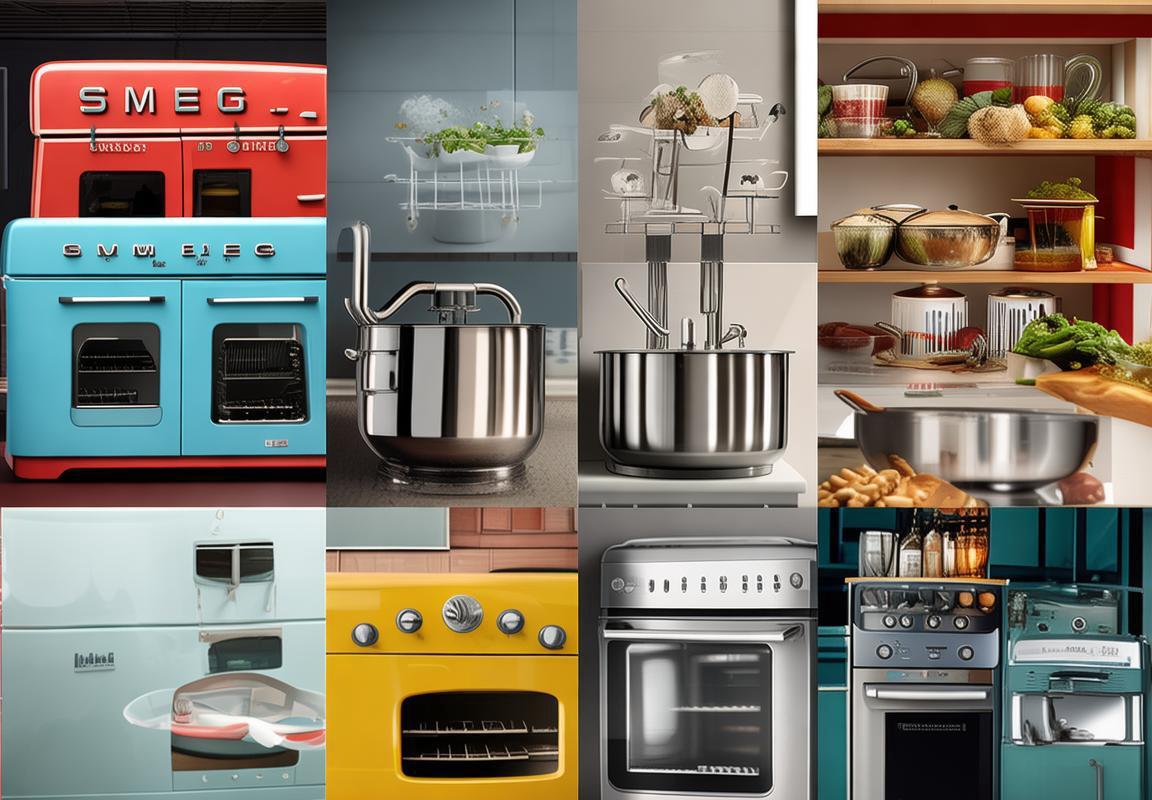In the ever-evolving landscape of the kitchen appliance industry, the dynamics between local suppliers and international markets have shifted significantly. The rise of import substitution programs has become a pivotal trend, particularly in Europe and America, as consumers and businesses seek to support local economies while enjoying high-quality products. This article delves into the intricacies of the kitchen appliance market, exploring the factors that drive the growth of local brands, the consumer preferences shaping market dynamics, and the challenges and opportunities faced by local suppliers. Additionally, we’ll examine the transformative power of technological innovation and the increasing importance of sustainability and energy efficiency in shaping the future of the sector.
Introduction to the Kitchen Appliance Industry in Europe and America
The kitchen appliance industry in Europe and America has seen a remarkable evolution over the years, transforming from simple, functional devices to sophisticated, integrated systems that enhance the overall cooking experience. From the bustling streets of New York City to the cozy homes in Paris, the kitchen has become a hub of innovation, convenience, and style. Let’s delve into the dynamic landscape of this industry on both continents.
In Europe, the kitchen appliance market is characterized by its diversity and sophistication. Countries like Germany, Italy, and the United Kingdom have long been known for their premium appliance brands, offering products that cater to a wide range of budgets and needs. From high-end dishwashers and refrigerators to compact, energy-efficient models, European consumers have a plethora of options to choose from.
Similarly, the American kitchen appliance market is a testament to the country’s love for technology and innovation. Brands like KitchenAid, Whirlpool, and GE have established themselves as leaders in the industry, providing a mix of cutting-edge features and timeless designs. The U.S. market is also marked by a strong emphasis on sustainability and energy efficiency, with manufacturers continually pushing the boundaries to reduce their environmental footprint.
One of the key trends in both regions is the rise of smart kitchen appliances. These devices, equipped with IoT capabilities, allow users to control and monitor their appliances remotely, offering convenience and efficiency. For instance, smart ovens can be preheated from a smartphone, and smart refrigerators can provide dietary recommendations based on the user’s food preferences and health goals.
In Europe, the kitchen appliance industry is also witnessing a shift towards more personalized and modular products. Consumers are increasingly seeking appliances that can be customized to fit their unique kitchen layouts and design preferences. This has led to a surge in demand for modular kitchen systems and appliances that can be easily replaced or upgraded.
On the American side, the focus on sustainability is a driving force behind the development of eco-friendly kitchen appliances. Energy Star-certified refrigerators, dishwashers, and cooktops are becoming more common, as consumers become more environmentally conscious and look for ways to reduce their carbon footprint.
The import substitution program has played a significant role in both Europe and America. As local suppliers strive to meet the growing demand for high-quality appliances, they are increasingly investing in research and development to create products that can rival their international counterparts. This trend is particularly prominent in Europe, where a strong emphasis on local craftsmanship and quality has led to a surge in domestic brands.
Local suppliers in both regions are also benefitting from government initiatives aimed at promoting domestic production and reducing reliance on imports. These programs often provide financial incentives, tax breaks, and other support mechanisms to encourage companies to invest in their manufacturing capabilities and develop new technologies.
The competition between local and international brands has been fierce, but it has also led to a more dynamic market. Local suppliers are not just competing on price but are also focusing on innovation, design, and customer service. This has resulted in a more diverse and innovative product range, giving consumers more choices.
In Europe, the demand for locally produced kitchen appliances is often driven by a sense of pride and quality assurance. Consumers are more likely to purchase products from brands they can relate to, knowing that the manufacturing process and supply chain are transparent and accountable.
Similarly, in America, local suppliers are finding success by focusing on niche markets and specialized products. Whether it’s commercial-grade appliances for professional chefs or eco-friendly models for eco-conscious consumers, there is a clear opportunity for local suppliers to carve out a unique position in the market.
In conclusion, the kitchen appliance industry in Europe and America is a complex and ever-evolving landscape. Driven by consumer preferences, technological advancements, and sustainability concerns, the market is ripe for local suppliers to capitalize on the import substitution trend. By focusing on innovation, quality, and customer satisfaction, these suppliers can successfully compete with international giants and contribute to the growth of their respective economies.

Understanding Import Substitution Trends
The kitchen appliance industry in both Europe and America has undergone a fascinating transformation, marked by a shift towards import substitution. This trend is not just a passing fad but a strategic move driven by a variety of factors. From economic considerations to consumer preferences, understanding the nuances of import substitution is crucial for suppliers and manufacturers looking to capitalize on this evolving market.
In recent years, the cost of importing goods has soared, largely due to geopolitical tensions and trade disputes. As a result, many European and American consumers are reevaluating their reliance on foreign-made appliances. This shift is not solely about cost savings; it’s also a reflection of a growing preference for locally produced goods that align with regional standards and sustainability practices.
Local suppliers are seizing this opportunity by investing in research and development to create products that not only meet the stringent quality expectations but also cater to the specific needs of their domestic markets. This includes a focus on energy efficiency, which has become a cornerstone of modern kitchen appliance design.
The demand for locally manufactured appliances is also being fueled by a rise in national pride and the desire to support local economies. Consumers are increasingly aware of the environmental impact of long-distance shipping and are gravitating towards products that are produced closer to home. This sentiment is particularly strong in Europe, where there’s a deep-seated commitment to sustainability and eco-friendly living.
As the trend gains momentum, it’s becoming clear that import substitution is not a one-size-fits-all approach. It requires a nuanced understanding of each market’s unique characteristics. In Europe, for example, there’s a diverse range of countries with different cultural preferences and regulatory environments. Germany, known for its engineering prowess, might favor high-tech kitchen appliances, while Italy might lean towards aesthetically pleasing, artisanal designs.
In the United States, the trend is further complicated by the presence of a strong domestic appliance industry. Brands like KitchenAid and GE have long been staples in American kitchens, and the rise of import substitution is prompting them to innovate and compete more fiercely. The competition is heating up, with American manufacturers focusing on product differentiation, enhanced customer service, and strategic partnerships to maintain their market share.
Moreover, the rise of online marketplaces and direct-to-consumer models has given local suppliers a direct channel to consumers, bypassing traditional distributors and retailers. This has democratized the market, allowing smaller, niche players to emerge and gain traction. These suppliers often bring a level of customization and service that larger, international brands may struggle to match.
The rise of smart kitchen appliances is another significant driver of import substitution. As technology advances, consumers are seeking appliances that not only perform well but also integrate seamlessly with their digital lifestyles. This has created a fertile ground for local suppliers who can adapt quickly to technological changes and offer innovative solutions.
In the realm of sustainability, the kitchen appliance industry is facing increased pressure to reduce its environmental footprint. Local suppliers are often better positioned to adopt eco-friendly practices, as they are more attuned to local regulations and consumer expectations. This focus on sustainability is not just a trend; it’s a long-term strategy for suppliers looking to build a resilient business model.
Despite these opportunities, the path to successful import substitution is fraught with challenges. Local suppliers must navigate complex supply chains, manage production costs, and ensure quality control. They also need to invest in marketing and branding to differentiate their products in a crowded market.
Moreover, the global kitchen appliance industry is subject to rapid technological advancements and changing consumer behaviors. Suppliers must be agile and adaptable, constantly evolving their offerings to keep pace with these changes. This requires a deep understanding of market trends and the ability to anticipate future needs.
In conclusion, the trend towards import substitution in the kitchen appliance industry is a complex and multifaceted phenomenon. It’s driven by economic, environmental, and consumer-driven factors, and it presents both opportunities and challenges for local suppliers. By staying informed, investing in innovation, and focusing on customer satisfaction, these suppliers can carve out a successful niche in the dynamic European and American markets.

The Role of Local Suppliers in the Import Substitution Program
In the ever-evolving landscape of the kitchen appliance industry, local suppliers play a pivotal role in the import substitution program. This initiative is not just about reducing dependence on foreign goods but also about fostering economic growth and innovation within domestic markets. Let’s delve into how local suppliers contribute to this transformative process.
Local suppliers often have a deep understanding of the regional market’s unique needs and preferences. They are able to tailor their products to meet these specific requirements, which can be a significant advantage over imported goods that may not be as well-suited to local tastes and conditions. This customization can range from design aesthetics to functionality, ensuring that consumers get appliances that truly resonate with their daily lives.
One of the most tangible benefits of local suppliers in the import substitution program is the creation of jobs. By sourcing appliances locally, manufacturers can employ a workforce that is familiar with the local market, reducing the need for imported labor. This not only boosts employment rates but also fosters a sense of community and economic stability within the region.
Moreover, local suppliers are more likely to invest in research and development, leading to the innovation of new products that cater to the evolving needs of consumers. This R&D focus can lead to more energy-efficient appliances, which is not only environmentally friendly but also cost-effective for consumers. As the world becomes more conscious of sustainability, local suppliers are well-positioned to lead the charge in developing eco-friendly kitchen appliances.
Another critical aspect of local suppliers’ role is the integration of local supply chains. By sourcing components and materials from within the country, suppliers can reduce transportation costs and carbon footprints. This integration also strengthens the domestic economy, as it reduces reliance on foreign suppliers and supports local businesses.
In terms of regulatory compliance, local suppliers are often more adept at navigating the intricacies of national standards and certifications. This ensures that the appliances they produce meet the necessary safety and quality benchmarks, which is crucial for consumer trust and market credibility.
However, the journey for local suppliers in the import substitution program is not without its challenges. One major hurdle is the competition from established international brands that have already gained a strong foothold in the market. These brands often benefit from economies of scale, global supply chains, and established brand recognition, making it difficult for local suppliers to compete on price and features.
To overcome this, local suppliers must focus on differentiation. This could mean investing in cutting-edge technology, offering exceptional customer service, or creating a unique brand identity that resonates with local consumers. By carving out a niche, local suppliers can establish a loyal customer base that values their products over those of international competitors.
Additionally, local suppliers need to be strategic in their marketing efforts. Understanding the local consumer behavior and leveraging effective marketing channels can help them reach their target audience more effectively. This includes leveraging social media, local influencers, and community events to build brand awareness and trust.
The import substitution program also necessitates a strong partnership between suppliers, manufacturers, and the government. Governments can play a crucial role by providing incentives such as subsidies, tax breaks, or grants to support local production. These policies can help level the playing field and make it more viable for local suppliers to compete with imported goods.
In conclusion, local suppliers are instrumental in the import substitution program by offering tailored products, creating jobs, fostering innovation, and integrating local supply chains. While challenges exist, strategic differentiation, effective marketing, and government support can pave the way for their success. As the global kitchen appliance market continues to evolve, the role of local suppliers in shaping this landscape will undoubtedly grow in importance.

Key Factors Driving the Growth of Local Kitchen Appliance Brands
In the evolving landscape of the kitchen appliance market, local brands are increasingly gaining traction. Several key factors are propelling this growth, reflecting a shift in consumer preferences and market dynamics.
Consumer Preference for Local BrandsThe preference for local kitchen appliance brands is often rooted in a sense of community and loyalty. Consumers appreciate the fact that purchasing local supports the local economy and fosters a connection to their community. This sentiment is particularly strong in Europe and America, where there’s a deep-seated pride in homegrown products.
Quality and CraftsmanshipLocal suppliers often pride themselves on the quality and craftsmanship of their products. With a focus on durability and reliability, these brands can compete with international giants by offering appliances that are tailored to the specific needs and preferences of local consumers.
Customization and Local AdaptationLocal brands have the advantage of being more adaptable to local conditions. They can design appliances that cater to unique climate challenges, cultural preferences, or even the specific cooking habits of their customers. This level of customization is not always possible with imported goods.
Competitive PricingImport substitution programs often benefit from competitive pricing. Local suppliers can sometimes offer more affordable options without compromising on quality, making their products more accessible to a broader segment of the market.
Government Incentives and PoliciesGovernments in both Europe and America are increasingly offering incentives and policies to support local manufacturers. These can range from tax breaks to grants for research and development, which helps local brands innovate and expand their market presence.
Technological AdvancementsAdvancements in technology have allowed local brands to catch up with, and in some cases surpass, international competitors. By leveraging the latest in materials, design, and energy efficiency, these brands are able to offer cutting-edge products that appeal to tech-savvy consumers.
Sustainability and Ethical ProductionConsumers are becoming more environmentally and socially conscious. Local brands that emphasize sustainability and ethical production are gaining a competitive edge. They can tout their commitment to reducing carbon footprints and using eco-friendly materials, which resonates with today’s consumer values.
Marketing and Branding EffortsEffective marketing and branding play a crucial role in the growth of local kitchen appliance brands. These brands are often better equipped to understand and leverage local marketing channels, creating campaigns that resonate with their target audience. From community events to online engagement, local brands are finding innovative ways to build their brand identity.
Diverse Product RangeLocal suppliers often offer a wider range of products compared to larger, multinational corporations. This diversity allows them to cater to niche markets and specialized needs, ensuring they have something for everyone in their local community.
Customer Service and SupportLocal brands typically provide exceptional customer service and support. With a physical presence in the community, they can offer faster response times and more personalized assistance, which can be a significant draw for customers looking for reliable service and support.
Collaboration and PartnershipsLocal brands are often more open to collaboration and partnerships. By teaming up with other local businesses, they can create synergistic effects that enhance their offerings and market reach. This can include everything from co-branded products to joint marketing initiatives.
Economic ResilienceThe economic resilience of local brands is another factor contributing to their growth. During economic downturns, consumers may prioritize local brands over imported ones, as they perceive them to be more stable and reliable.
In conclusion, the growth of local kitchen appliance brands is driven by a combination of factors, including consumer preference, quality and craftsmanship, customization, competitive pricing, government support, technological advancements, sustainability efforts, effective marketing, diverse product ranges, exceptional customer service, collaboration, and economic resilience. These factors collectively create a strong foundation for local brands to thrive in an increasingly competitive market.

Consumer Preferences and Market Dynamics in Europe and America
In the European and American kitchen appliance markets, consumer preferences and market dynamics are shaped by a myriad of factors that influence the rise and fall of various brands. Understanding these elements is crucial for suppliers and manufacturers looking to establish or maintain a foothold in these competitive regions.
The Rise of Smart and Energy-Efficient AppliancesConsumers in both Europe and America are increasingly gravitating towards smart kitchen appliances that offer convenience, connectivity, and energy-saving features. From smart refrigerators that can track groceries and remind users to purchase more to induction cooktops that optimize energy use, these advancements are not just about technology but also about sustainability.
The Importance of Aesthetics and DesignAesthetics play a significant role in kitchen appliance purchasing decisions. Modern consumers are not just looking for functionality; they seek appliances that complement their kitchen’s style and add a touch of elegance. The rise of minimalist designs, sleek lines, and customizable colors has allowed local brands to differentiate themselves in a crowded market.
Brand Loyalty and TrustLocal brands often have a competitive edge when it comes to fostering brand loyalty. Consumers in both regions tend to have strong preferences for well-known, trusted brands, especially when it comes to appliances that require a long-term investment. This loyalty is built on a history of quality, reliability, and customer service.
Health and Safety ConcernsThe kitchen is a place where health and safety are paramount. As a result, consumers in Europe and America are increasingly interested in appliances that meet stringent safety standards and are free from harmful chemicals. Brands that prioritize health and safety in their manufacturing processes are likely to appeal to these concerned consumers.
Economic Factors and Budget SensitivityThe economic climate has a profound impact on consumer spending habits. During economic downturns, price becomes a major consideration, and budget-sensitive consumers may opt for more affordable options. Conversely, during economic upswings, consumers may be more willing to invest in premium appliances.
The Influence of Online ShoppingThe rise of e-commerce has changed the landscape of the kitchen appliance market. Online platforms offer consumers a wide range of options, easy comparisons, and the convenience of home delivery. Local suppliers must adapt by optimizing their online presence and ensuring their products are readily available to an increasingly digital consumer base.
Sustainability and Environmental ResponsibilitySustainability is a growing concern for consumers worldwide, and the kitchen appliance market is no exception. European and American consumers are more likely to purchase appliances from brands that demonstrate environmental responsibility through sustainable practices, recyclable materials, and energy-efficient designs.
Cultural and Lifestyle TrendsCultural shifts and lifestyle changes also influence consumer preferences. For example, the growing popularity of healthier eating habits has spurred the demand for high-quality food processors and juicers. Similarly, the trend towards cooking at home, as opposed to dining out, has increased the need for versatile cookware and appliances that can handle a variety of recipes.
Innovation and Technological AdvancementsContinuous innovation drives the kitchen appliance market. New technologies, such as touchscreens, voice control, and integrated cooking systems, are becoming standard features in high-end appliances. Local brands that can innovate and keep pace with these advancements will be well-positioned to capture market share.
Certifications and Standards ComplianceLastly, compliance with various certifications and standards is critical. For instance, appliances that meet the Energy Star or equivalent ratings are often more attractive to environmentally conscious consumers. Local suppliers must ensure their products adhere to these standards to be competitive.
These factors intertwine to create a complex tapestry of consumer preferences and market dynamics in the European and American kitchen appliance markets. suppliers must stay attuned to these trends to effectively cater to the needs and desires of their target consumers.

Case Studies: Successful Import Substitution Efforts
In the realm of kitchen appliance markets, several brands have made a name for themselves through successful import substitution efforts. These case studies highlight their strategies and the outcomes that have propelled them to the forefront.
The Italian appliance brand SMEG has become synonymous with retro charm and high-quality products. Their success can be attributed to a strong focus on design and craftsmanship, which resonates with consumers who appreciate a touch of nostalgia in their modern kitchens. By emphasizing Italian heritage and the artisanship behind their products, SMEG has managed to carve out a niche market that values both aesthetics and functionality.
Another shining example is the German company Miele, which has been a leader in kitchen appliances for over a century. Miele’s commitment to innovation and sustainability has played a crucial role in their import substitution strategy. By investing in research and development, they’ve introduced eco-friendly appliances that cater to environmentally conscious consumers. Their emphasis on quality and customer service has also helped maintain a loyal customer base.
In the United States, KitchenAid has successfully transitioned from a manufacturer of commercial mixers to a household name. Their approach has been to diversify their product range while maintaining a consistent brand identity. By offering a wide array of kitchen appliances that cater to different lifestyles and budgets, KitchenAid has become a go-to brand for American consumers. Their collaboration with celebrity chefs and influencers has also helped in building a strong brand image.
In the realm of small kitchen appliances, the British brand Dualit has made a significant impact. Their success lies in their ability to produce high-quality, reliable appliances that are both stylish and practical. By focusing on the UK market, Dualit has become a staple in many British kitchens. Their commitment to design innovation and the use of premium materials has helped them to compete with international brands while supporting local manufacturing.
The Spanish company Fagor has expanded its reach beyond its home country by focusing on affordability and functionality. Their strategy has been to provide value-for-money appliances that meet the needs of consumers who are cost-conscious but still demand quality. By leveraging their local manufacturing capabilities, Fagor has been able to offer competitive pricing without compromising on performance.
In the context of South Korea, LG Electronics has made a significant mark in the kitchen appliance market through its innovative approach and global expansion. Their success can be attributed to a combination of cutting-edge technology, smart appliances, and a strong emphasis on design. LG’s ability to integrate smart home technology into kitchen appliances has resonated with consumers who are looking for convenience and connectivity.
In France, Groupe SEB has become a powerhouse in the small kitchen appliance market. Through brands like Tefal and Rowenta, SEB has managed to create a diverse portfolio that caters to a wide range of consumer needs. Their success lies in their focus on product innovation, marketing, and distribution channels. By understanding the French consumer’s preference for high-quality, French-designed products, SEB has been able to maintain a strong presence in the domestic market.
The Japanese company Panasonic has a long-standing reputation for quality and reliability in kitchen appliances. Their import substitution efforts have been driven by a commitment to energy efficiency and technology innovation. By offering appliances that not only perform well but also help save energy, Panasonic has been able to attract environmentally conscious consumers.
These case studies demonstrate that successful import substitution in the kitchen appliance industry often hinges on a combination of factors, including a focus on design, innovation, sustainability, and customer satisfaction. By understanding local market dynamics and consumer preferences, these brands have been able to carve out a unique position in the global market while supporting local economies.

Challenges and Opportunities for Local Suppliers
Navigating the complexities of the kitchen appliance market, local suppliers play a pivotal role in the import substitution program. These suppliers face a myriad of challenges and opportunities that shape their ability to compete effectively. Let’s delve into some of the key factors that influence their journey.
The competitive landscape for local suppliers is constantly evolving. With the rise of globalization, the market is flooded with a variety of international brands that offer cutting-edge technology and sleek designs. This competition has forced local suppliers to innovate and differentiate themselves. They must not only match the quality and functionality of foreign appliances but also offer something unique to capture consumer interest.
One significant challenge local suppliers encounter is the high cost of raw materials. Fluctuations in global commodity prices can lead to substantial increases in production costs, squeezing profit margins. Moreover, the reliance on imported components can exacerbate this issue, as currency exchange rates can add to the financial burden.
On the flip side, opportunities arise from the increasing demand for sustainable and eco-friendly appliances. As consumers in Europe and America grow more environmentally conscious, local suppliers have the chance to capitalize on this trend by offering products that are energy-efficient and have a lower carbon footprint. This focus on sustainability can not only resonate with environmentally conscious consumers but also open up new markets, especially in regions with strong environmental policies.
The integration of smart technology into kitchen appliances is another opportunity for local suppliers. With the advent of the Internet of Things (IoT), there’s a growing need for appliances that can connect to home automation systems. Local suppliers can leverage their understanding of local market needs and preferences to develop innovative smart kitchen solutions that appeal to tech-savvy consumers.
However, the transition to smart appliances also brings its own set of challenges. Suppliers must invest in research and development to stay ahead of the curve, and they must navigate complex supply chains to source the necessary components. Additionally, they need to ensure that their products are compatible with a wide range of home automation systems, which can be a significant technical challenge.
One of the most critical opportunities for local suppliers lies in the customization of products. Unlike mass-produced international brands, local suppliers can offer more personalized solutions that cater to specific consumer needs. This could range from adapting to local cooking habits to integrating features that address unique regional preferences. Such customization can significantly enhance customer satisfaction and loyalty.
Another challenge is the need for robust quality control measures. As consumers become more discerning, they expect appliances that are not only aesthetically pleasing but also reliable and durable. Local suppliers must invest in quality assurance processes to meet these high standards, which can be a costly endeavor but is crucial for long-term success.
In terms of distribution, local suppliers must find effective ways to reach their target market. This involves establishing strong relationships with retailers and ensuring that their products are well-positioned on store shelves. Online sales platforms have also become a vital channel for reaching customers, and local suppliers must develop a strong online presence to compete effectively in this digital landscape.
Furthermore, the ability to provide after-sales service is a key differentiator for local suppliers. Offering comprehensive customer support and service can build trust and loyalty among consumers, which is particularly important when dealing with expensive and critical household appliances.
In conclusion, while the path is fraught with challenges, local suppliers in the kitchen appliance industry have numerous opportunities to thrive. By focusing on innovation, sustainability, customization, quality, and service, these suppliers can carve out a niche for themselves in the competitive market. It’s a delicate balance of embracing new technologies and adapting to market trends while maintaining the essence of local craftsmanship and customer service.

Technological Innovation and Its Impact on Kitchen Appliances
In the rapidly evolving landscape of kitchen appliances, technological innovation has become a cornerstone for differentiation and market leadership. The impact of these advancements stretches beyond mere efficiency gains, influencing consumer preferences, market dynamics, and the very fabric of how we interact with our appliances.
Smart Connectivity Revolutionizes the KitchenModern kitchen appliances are no longer just tools for cooking and cleaning; they are now connected devices that offer a level of interactivity previously unimaginable. Smart refrigerators, ovens, and dishwashers, equipped with Wi-Fi capabilities, allow users to monitor and control their appliances remotely via smartphones or tablets. This connectivity not only enhances convenience but also provides valuable data that can be used to optimize energy use and maintenance schedules.
Energy Efficiency as a Competitive EdgeEnergy efficiency has become a key selling point for kitchen appliances, especially in regions where energy costs are a significant concern. Innovations in insulation, motor technology, and heating elements have led to appliances that consume less power while maintaining or improving performance. Suppliers that prioritize energy efficiency not only cater to environmentally conscious consumers but also to those looking to reduce their utility bills.
Customization and PersonalizationThe rise of AI and machine learning has enabled kitchen appliances to adapt to individual user preferences. For instance, smart ovens can learn from the user’s cooking habits and adjust settings for optimal results. This level of personalization is changing how consumers perceive their appliances, shifting the focus from one-size-fits-all solutions to tailor-made devices that enhance the cooking experience.
Health and Safety FeaturesWith a growing awareness of health and safety, kitchen appliance manufacturers are incorporating features that protect users and their families. For example, induction cooktops provide a safer cooking experience with less risk of burns compared to traditional gas burners. Additionally, features like child locks and automatic shut-offs in ovens and stovetops are becoming standard, reflecting a commitment to user safety.
Interactive User InterfacesThe user interface has seen a significant transformation with the integration of touchscreens, voice commands, and gesture controls. These interfaces make appliances more intuitive and accessible, particularly for individuals with disabilities or those who may find traditional dials and buttons challenging to use. The evolution of user interfaces is also driving the development of new interactive features, such as recipe guides and cooking tutorials, that enrich the appliance experience.
Sustainability and Eco-Friendly MaterialsAs consumers become more environmentally conscious, there’s a growing demand for appliances that are not only energy-efficient but also made from sustainable materials. This shift has spurred innovation in materials science, with manufacturers exploring alternatives to traditional plastics and metals that are both durable and eco-friendly. The result is a new wave of kitchen appliances that are as kind to the planet as they are to the user’s wallet.
Integration with Smart Home SystemsThe kitchen is increasingly becoming a central hub in the smart home ecosystem. Appliances that can integrate with other smart devices, such as lighting, security systems, and climate control, offer homeowners a seamless and efficient living environment. This integration is not just about convenience; it’s about creating a cohesive and intelligent living space that can be controlled and optimized from a single interface.
Predictive Maintenance and AI-Powered DiagnosticsAppliances equipped with AI and machine learning can predict maintenance needs, reducing downtime and unexpected repairs. This proactive approach to maintenance not only extends the lifespan of the appliance but also provides peace of mind to the consumer. By analyzing usage patterns and performance data, appliances can alert users to potential issues before they become problems.
The Role of E-commerce in Spreading InnovationE-commerce platforms have democratized access to the latest kitchen appliance innovations. Consumers can now explore a wide range of products from around the world, making it easier for new and emerging brands to reach a global audience. This shift has also accelerated the pace of innovation as manufacturers compete for online market share.
In conclusion, technological innovation in kitchen appliances is reshaping the industry in profound ways. From smart connectivity and energy efficiency to health and safety features, the impact of these advancements is multifaceted, offering both challenges and opportunities for suppliers to create value and meet the evolving demands of consumers.

Sustainability and Energy Efficiency: A New Frontier for Suppliers
In today’s rapidly evolving market, sustainability and energy efficiency have emerged as critical considerations for kitchen appliance suppliers. These factors are not just about meeting regulatory standards but also about staying ahead of consumer expectations and industry trends. Here’s how these aspects are reshaping the landscape for suppliers:
Manufacturers are increasingly focusing on the lifecycle of their products, not just the initial sale. They’re integrating sustainable practices into their supply chains, from sourcing materials to designing for longevity and recyclability. This shift requires suppliers to adapt by offering eco-friendly components and materials.
Consumers are more environmentally conscious than ever before. They’re not just looking for appliances that save energy but also those that are produced with sustainable methods. Suppliers that can provide these certifications are gaining a competitive edge, as they cater to a growing market segment.
Energy efficiency is not just a regulatory requirement; it’s a cost-saving opportunity for consumers. Suppliers that offer appliances with high energy ratings are likely to see increased demand. This means investing in R&D to develop more efficient motors, heat exchangers, and smart technologies that optimize energy use.
The rise of smart appliances has also brought about a new wave of sustainability. These devices can be programmed to use energy during off-peak hours, reducing overall consumption. Suppliers must ensure that their components are compatible with these smart systems and contribute to their energy-saving capabilities.
In the kitchen appliance sector, innovation often means finding ways to reduce waste. Suppliers are looking for materials that are lighter, more durable, and easier to recycle. This pursuit has led to the development of new alloys, composites, and even biodegradable plastics.
As regulations tighten, suppliers must navigate a complex web of compliance. This includes adhering to local and international environmental standards, which can vary widely. Suppliers that can provide a seamless solution across different markets have an advantage.
The global push for sustainability is also influencing design trends. Appliances that are sleeker, with hidden controls and seamless integration into kitchen cabinets, are becoming more popular. Suppliers need to be agile, offering a range of aesthetic solutions that cater to these preferences.
Energy-efficient appliances often come with a higher upfront cost. Suppliers must balance this with the long-term savings that consumers will experience. Offering financing options or educational materials on the benefits of energy efficiency can help bridge the gap.
The trend towards modular design has also gained traction. This approach allows appliances to be easily upgraded or replaced with new modules, extending the life of the product. Suppliers must supply the necessary components to support this model.
The integration of renewable energy sources into kitchen appliances is another frontier. Suppliers that can offer components and systems compatible with solar or wind power are tapping into a growing market segment.
Lastly, the importance of after-sales service and customer support cannot be overstated. Sustainable and energy-efficient appliances often require more sophisticated maintenance. Suppliers that can provide comprehensive support are likely to build a loyal customer base.
In conclusion, the push for sustainability and energy efficiency in kitchen appliances is creating both challenges and opportunities for suppliers. By embracing these changes, suppliers can not only meet the demands of the market but also position themselves as leaders in the industry.

Conclusion: The Future of Import Substitution in the Kitchen Appliance Sector
The kitchen appliance sector is at a pivotal juncture, with the rise of import substitution programs reshaping the competitive landscape. This shift has presented local suppliers with both challenges and unprecedented opportunities. Here, we delve into the intricacies of this new reality.
Local suppliers are finding their feet in an environment that demands adaptability and innovation. The reliance on local manufacturing has spurred a wave of innovation, with suppliers pushing the boundaries of what’s possible in kitchen appliance design and functionality.
Market trends are leaning towards sustainable and eco-friendly appliances, which has prompted local suppliers to invest in green technology. This move not only aligns with consumer values but also opens doors to new market segments.
As consumer awareness of environmental issues grows, so does the demand for energy-efficient kitchen appliances. Suppliers that can demonstrate a commitment to sustainability are not only appealing to eco-conscious buyers but are also poised to benefit from regulatory incentives and subsidies.
The integration of smart technology into kitchen appliances is another avenue for growth. Local suppliers are leveraging advancements in AI and the Internet of Things (IoT) to create smart kitchen ecosystems that cater to the needs of the tech-savvy consumer.
The challenges are significant. Suppliers must navigate complex supply chains, often without the same level of global reach as their international counterparts. Quality control, particularly when it comes to components, can be a hurdles, requiring meticulous sourcing and meticulous oversight.
However, there’s a silver lining. The increased demand for locally made products means that suppliers can build stronger relationships with regional manufacturers, fostering a more robust and reliable supply network. This can lead to cost savings and improved product consistency.
The competitive landscape is also evolving. Local suppliers are not just battling it out with international giants; they are also facing new competitors in the form of domestic startups that are nimbler and more agile in their approach to product development.
To thrive in this dynamic market, local suppliers need to embrace a culture of continuous improvement. This involves investing in research and development, not just to create new products but to refine existing ones and ensure they meet the stringent requirements of international standards.
Collaboration with educational institutions and research centers is key. By fostering a pipeline of skilled workers, suppliers can ensure they have the talent pool needed to drive innovation and maintain a competitive edge.
In the realm of marketing and branding, local suppliers must communicate the unique benefits of their products effectively. This often means redefining their value proposition to emphasize local craftsmanship, quality, and community support.
The financial landscape presents another challenge. Local suppliers may face limitations in securing funding compared to established international players. However, the rise of crowdfunding and alternative financing options is opening new doors for small and medium-sized enterprises (SMEs) in the kitchen appliance sector.
Despite the hurdles, the opportunities for local suppliers are substantial. As consumers increasingly seek out local and sustainable options, those suppliers that can tap into this trend will find themselves well-positioned for growth. The rise of e-commerce is also expanding their reach, allowing them to market their products beyond regional boundaries.
In conclusion, the future of import substitution in the kitchen appliance sector is a complex tapestry of challenges and opportunities. Local suppliers must navigate a landscape that demands innovation, sustainability, and strategic partnerships. By embracing these dynamics, they can carve out a niche for themselves and contribute to the resurgence of local manufacturing in the kitchen appliance industry.